

Discover the world's most endangered species. Wildscreen's Arkive project was launched in 2003 and grew to become the world's biggest encyclopaedia of life on Earth. With the help of over 7,000 of the world’s best wildlife filmmakers and photographers, conservationists and scientists, Arkive.org featured multi-media fact-files for more than 16,000 endangered species. Freely accessible to everyone, over half a million people every month, from over 200 countries, used Arkive to learn and discover the wonders of the natural world.
Since 2013 Wildscreen was unable to raise sufficient funds from trusts, foundations, corporates and individual donors to support the year-round costs of keeping Arkive online. Therefore, the charity had been using its reserves to keep the project online and was unable to fund any dedicated staff to maintain Arkive, let alone future-proof it, for over half a decade. Despite appeals for support, just 85 of our 5.6 million users in 2018 made a donation. Animal Diversity Web. Photographic Dictionary.
Animal Pedia - The Free Online Animal Encyclopedia. Animals (Animalia. Animal Facts Encyclopedia. Animal-World, Dr. Jungles Exotic Pets, Animals, Aquariums. Extensive encyclopedia of animal information. A-Z Animals - Animal Facts, Information, Pictures, Videos, Resources and Links. Wild Animals Online - An online encyclopedia of wild animals - facts, photos, pictures, information. Category:Lists of animals. Book:Animal. Animal. Most known animal phyla appeared in the fossil record as marine species during the Cambrian explosion, about 542 million years ago.

Lists of animals. List of animal names. Wikipedia list article For many animals, particularly domesticated ones, there are specific names for males, females, young, and groups.
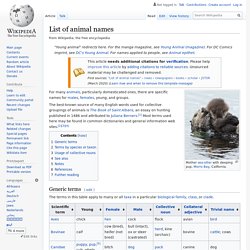
The best-known source of many English words used for collective groupings of animals is The Book of Saint Albans, an essay on hunting published in 1486 and attributed to Juliana Berners.[1] Most terms used here may be found in common dictionaries and general information web sites.[2][3][4] Generic terms[edit] Terms by species or taxon[edit] Usage of collective nouns[edit] Merriam-Webster writes that most terms of venery fell out of use in the 16th century, including a "murder" for crows. Writing for Audubon, Nicholas Lund says that many such terms are not used in actuality.
See also[edit] Notes[edit] References[edit] Further reading[edit] Black Widow Spider Bite Symptoms, Diagnosis, Treatment and Prevention on eMedicineHealth. Latrodectus. Latrodectus is a genus of spider, in the family Theridiidae, which contains 32 recognized species.
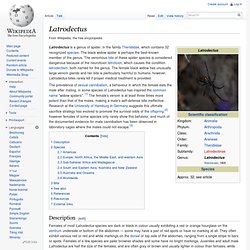
The black widow spider is perhaps the best-known member of the genus. The venomous bite of these spider species is considered dangerous because of the neurotoxin latrotoxin, which causes the condition latrodectism, both named for the genus. The female black widow has unusually large venom glands and her bite is particularly harmful to humans; however, Latrodectus bites rarely kill if proper medical treatment is provided.
The prevalence of sexual cannibalism, a behaviour in which the female eats the male after mating, in some species of Latrodectus has inspired the common name "widow spiders". [1] The female's venom is at least three times more potent than that of the males, making a male's self-defense bite ineffective. Description[edit] Latrodectus. Spider Identification Chart - Venomous or Dangerous? Psychoactive Toad Venom Vault. Cane Toads, Cane Toad Pictures, Cane Toad Facts. The much maligned venomous cane toads earned their bad reputation shortly after being released into the Australian ecology in 1935 with the hope that they would control the destructive cane beetle population.
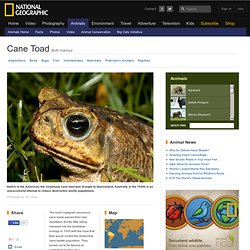
They turned out to be failures at controlling beetles, but remarkably successful at reproducing and spreading themselves. About 3,000 cane toads were released in the sugarcane plantations of north Queensland in 1935. They now number well into the millions, and their still expanding range covers thousands of square miles in northeastern Australia. They are considered pests, and government eradication efforts include asking residents to help collect and dispose of them. Coral snake. North American coloration patterns[edit] Coral snakes are most notable for their red, yellow/white, and black colored banding.

(However, several nonvenomous species have similar coloration, including the scarlet snake, genus Cemophora, some of the kingsnakes and milk snakes, genus Lampropeltis, and the shovelnose snakes, genus Chionactis.) In some regions, the order of the bands distinguishes between the non-venomous mimics and the venomous coral snakes, inspiring some mnemonics — "Red on yellow, venom fellow; red on black, safe from attack.
" or "Red on black, venom lack; Red on yellow, killer fellow". Instead of poetry, remembering that yellow touches both other colors can indicate a cause for caution. However, this reliably applies only to coral snakes native to North America: Micrurus fulvius (Eastern or common coral snake), Micrurus tener (Texas coral snake), and Micruroides euryxanthus (Arizona coral snake), found in the southern and western United States. Behavior[edit] Gila monster. Taxonomy and etymology[edit] The two subspecies of Gila monster are the reticulated Gila monster (H. s. suspectum) and the banded Gila monster (H. s. cinctum).[3] The reticulated Gila monster lives in the southern region of the Gila monster's range, while the banded Gila monster is a northern subspecies occurring primarily in the Mojave Desert.

The reticulated Gila monster tends to have its lighter markings broken up by dark scales, giving it a reticulated pattern, while the banded Gila monster generally has more unbroken bands of lighter scales.[4][5] The Gila monster has one close living relative, the beaded lizard (H. horridum), as well as many extinct relatives in the Helodermatidae, the evolutionary history of which may be traced back to the Cretaceous period. The genus Heloderma has existed since the Miocene, when H. texana lived, and fragments of osteoderms from the Gila monster have been found in late Pleistocene (10,000–8,000 years ago) deposits near Las Vegas, Nevada. Dr. Gila Monsters, Gila Monster Pictures, Gila Monster Facts. At a length of up to two feet (0.6 meters) and a maximum weight exceeding five pounds (2.3 kilograms), the venomous Gila monster (pronounced HEE-luh) is the largest lizard native to the United States.
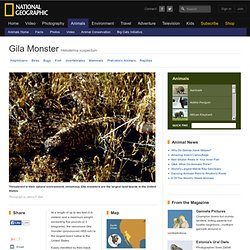
Easily identified by their black bodies marked with dramatic patterns of pink, orange, or yellow, Gilas are found in the Mojave, Sonoran, and Chihuahuan deserts of the southwestern U.S. and northwestern Mexico. They take their name from Arizona's Gila River basin, where they were first discovered. The Gila monster is one of only a handful of venomous lizards in the world. Others include the similar-looking Mexican beaded lizards, as well as iguanas and monitor lizards. Its venom is a fairly mild neurotoxin. Gilas are lethargic creatures that feed primarily on eggs raided from nests and newborn mammals. Gila populations are shrinking due primarily to human encroachment, and they are considered a threatened species.
Tetraodontidae. Pufferfish are generally believed to be the second-most poisonous vertebrates in the world, after the golden poison frog.
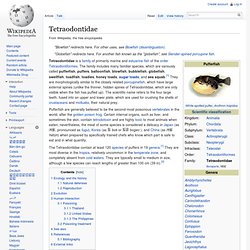
Certain internal organs, such as liver, and sometimes the skin, contain tetrodotoxin and are highly toxic to most animals when eaten; nevertheless, the meat of some species is considered a delicacy in Japan (as 河豚, pronounced as fugu), Korea (as 복 bok or 복어 bogeo ), and China (as 河豚 hétún) when prepared by specifically trained chefs who know which part is safe to eat and in what quantity. Puffer Fish Information - Pufferfish, Boxfish, and Cowfish. Wilderness: Pufferfish Poisoning. Colorado River toad. Description[edit] Range of Incilius alvarius in the United States (it also inhabits northwest Mexico) The Colorado River toad can grow to about 7.5 inches (190 mm) long and is the largest toad in the United States apart from the non-native cane toad (Rhinella marina).
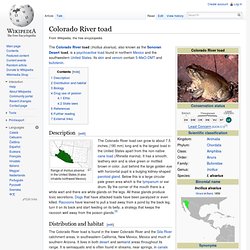
It has a smooth, leathery skin and is olive green or mottled brown in color. Just behind the large golden eye with horizontal pupil is a bulging kidney-shaped parotoid gland. Below this is a large circular pale green area which is the tympanum or ear drum. Cane toad. The cane toad has poison glands, and the tadpoles are highly toxic to most animals if ingested.
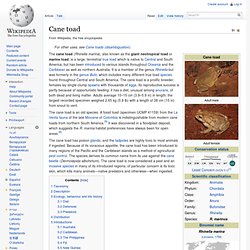
Because of its voracious appetite, the cane toad has been introduced to many regions of the Pacific and the Caribbean islands as a method of agricultural pest control. The species derives its common name from its use against the cane beetle (Dermolepida albohirtum). The cane toad is now considered a pest and an invasive species in many of its introduced regions; of particular concern is its toxic skin, which kills many animals—native predators and otherwise—when ingested.
Taxonomy[edit] Light-coloured cane toad. The Official Brown Recluse Spider. Identifying and Misidentifying the Brown Recluse Spider. Identifying and Misidentifying the Brown Recluse Spider Rick Vetter Dermatology Online Journal 5 (2): 7 Department of Entomology, University of California Riverside Abstract The brown recluse spider, Loxosceles reclusa, is often implicated as a cause of necrotic skin lesions.[1-3] Diagnoses are most commonly made by clinical appearance and infrequently is a spider seen, captured or identified at the time of the bite.[1, 2, 4-6] The brown recluse lives in a circumscribed area of the U.S. (the south central Midwest) with a few less common recluse species living in the more sparsely-populated southwest U.S.[7] In these areas, where spider populations may be dense, recluse spiders may be a cause of significant morbidity. American International Rattlesnake Museum - Albuquerque, New Mexico.